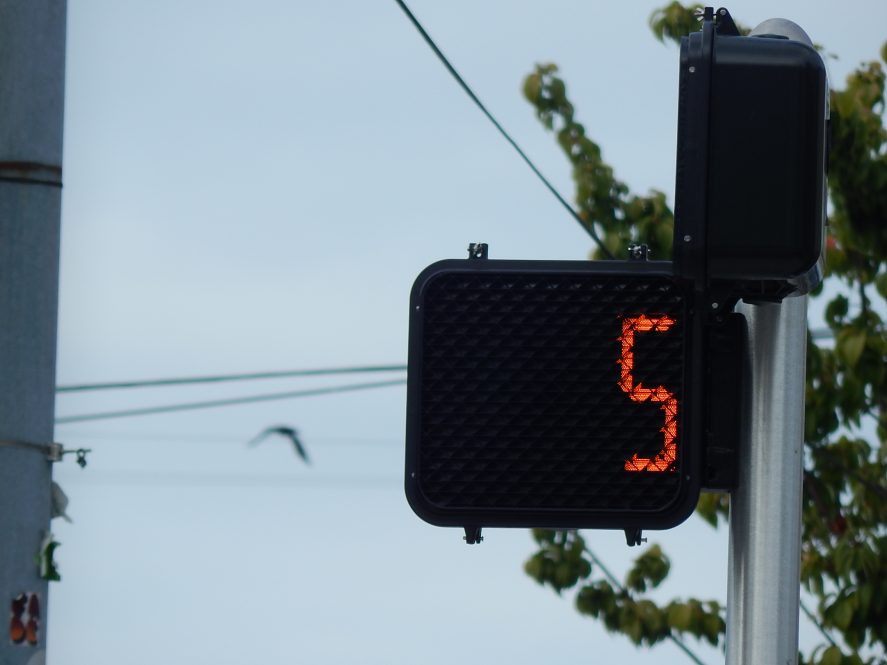UConn professor of civil and environmental engineering John Ivan has received a $200,000 grant from the Connecticut Department of Transportation to investigate the safety of a proposed approach to make pedestrian crossing signals more uniform throughout the state.
Kai Wang, statistician and transportation safety engineer for the Connecticut Transportation Institute, is the co-PI on this project. Other investigators include Marisa Auguste and Andrew Tucker, also from the Connecticut Transportation Institute.
Currently, intersection signals under the Connecticut Department of Transportation’s (CT DOT) jurisdiction use one of two kinds of pedestrian signals.
Some pedestrian signals in Connecticut use the “side street green” scheme. This means pedestrians can cross a major road while cars on that street have a red light, but cars on a smaller side street have a green light.
Other streets have exclusive signals for pedestrians. On these streets, the signs will present “Walk” or “Don’t Walk” signals specifically designed for pedestrians. These signals also often have a countdown to let pedestrians know how much time they have left to cross the road. Pedestrians can cross these streets while traffic in all directions is stopped.
Ivan’s team recently found that in intersections with exclusive pedestrian signals, there were fewer severe conflicts between pedestrians and vehicles. Severe conflicts were defined as when a collision was imminent.
The same study also found pedestrian compliance with signaling was higher with side street green phasing than with exclusive phasing signals.
The Connecticut Department of Transportation is considering implementing “concurrent” phasing. This type of signaling would install clearer pedestrian signals in areas that currently use side street green phasing. This means pedestrians would still cross the major road while the minor side street has a green light. But this plan would add “Walk” and “Don’t Walk” icons currently used with exclusive phasing to these intersections.
This would help make signals more uniform and thus less confusing throughout the state.
One challenge to this approach is possible confusion for motorists and pedestrians. Pedestrians expect exclusive phasing signals to mean all traffic is stopped, which would not be the case with the concurrent approach, while motorists are conditioned to not expect pedestrians to cross when they have a green light.
Ivan and his team will evaluate the safety of the proposed change from side street green to concurrent phasing. The project will identify intersections with significant daily pedestrian activity for the study, and compare data from before and after this change at all sites. The CT DOT will install new pedestrian signals at treatment locations.
The study will include four kinds of sites: intersections that continue using side street green phasing; intersections that use concurrent phasing without signage informing pedestrians and motorists of the change; intersections with concurrent phasing that do have this signage; and streets that keep exclusive pedestrian phasing.
Ivan’s safety evaluation will analyze changes in expected crash experience, distribution of the severity of pedestrian-vehicle interaction (which can range from undisturbed passage to a serious conflict where a motorist or pedestrian must make a drastic, unplanned move to avoid collision) and pedestrians’ and motorists’ compliance with signals.
The study period will include crash data from 36 months before any changes and then several months after implementation.
The study will also include a public awareness survey that assesses residents’ current understanding of traffic laws at intersections with signals and how these signals work.
Ivan’s team will leverage this baseline data to craft a 30-day educational campaign for pedestrians and motorists living in the area where new signals will be installed. After this campaign, the researchers will test public awareness of the planned changes and how well they understand signal operating at concurrent phasing intersections.
Ivan holds a Ph.D. in civil engineering from Northwestern University and is a registered professional engineer. His research interests include highway crash prediction, pedestrian safety, representing exposure to highway crashes, and statistical modeling of transportation systems. He is the associate editor of Accident Analysis and Prevention and an elected member of the Connecticut Academy of Science and Engineering.



